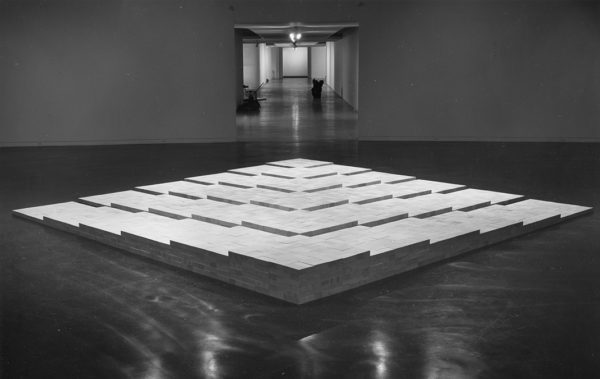
John Mason, Irvine, 1973, Photo by the artist, John Mason Archives
Here’s a look at what is planned for the 2018-2019 academic year. See what the Williamson is up to:
Exhibitions:
MEDITATION ON MATERIAL:
John Mason’s Firebrick Installations
AUGUST 25 – OCTOBER 21, 2018
Opening Reception: September 15, 7-9 p.m.
Williamson Gallery
Los Angeles was the site of a “revolution in clay” in which a small group of artists challenged studio pottery’s traditional focus on utilitarian ware to create sculptural forms. One of the central figures, John Mason, emerged as a sculptor of power, creating new works in clay that claimed equal footing with art in other media. Mason went on to work with clay and space as a visionary. In his Hudson River Series, Mason turned to manufactured firebricks as a medium, revealing most distinctly his deep interest in the role of the viewer and his fascination with the process of perception. The John Mason exhibition at the Williamson is dedicated to this series, and will consist of one very large firebrick installation, entitled Irvine, which demonstrates Mason’s fascination with the idea of perspective, including, but not limited to, the perspective of the viewer.
John Mason: Firebricks
And Shifting Notions of Scale and
Process in Sculpture
Presentation
Tuesday, October 16, 4:30 p.m.
Steele Hall, Rm. 101
This presentation by Edward Cella, director, Edward Cella Art & Architecture, will be given in conjunction with the exhibition Meditation on Material: John Mason’s Firebrick Installations.
SALT AND SILVER:
Early Photography 1840-1860
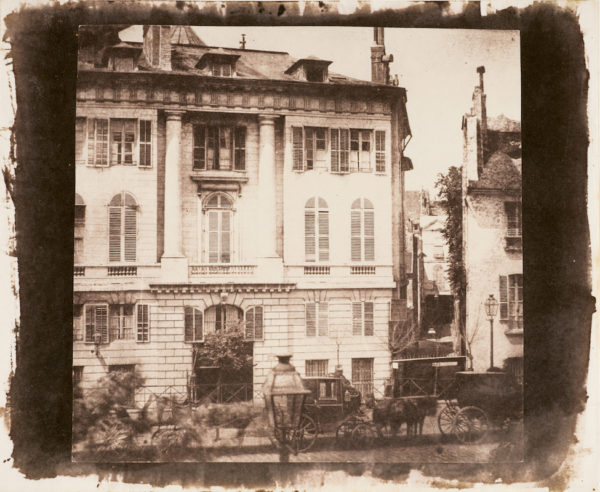
William Henry Fox Talbot, Scene in a Paris Street, 1843, salted paper print from paper negative, courtesy of the Wilson Centre for Photography
NOVEMBER 10 – DECEMBER 16, 2018
Opening Reception: November 10, 7-9 p.m.
Williamson Gallery
Salted paper prints, one of the earliest forms of photography, is a uniquely British invention, unveiled by William Henry Fox Talbot in 1839. Salt prints spread across the globe, creating a new visual language of the modern moment. This revolutionary technique transformed subjects from still lifes, portraits, landscapes and scenes of daily life into images with their own specific aesthetic: a soft, luxurious effect particular to this photographic process. The few salt prints that survive are seldom shown due to their fragility, and this exhibition is a singular opportunity to see the rarest and best early photographs of this type in the world. The exhibition was on view at the Tate Britain in London and at Yale University. Salt and Silver appears at the Williamson through the generosity of Jane and Michael Wilson and the Wilson Centre for Photography.
The Boston Globe‘s Mark Feeney offers an entertaining overview of the exhibition, well worth perusing, here.
Salt and Silver Symposium
Saturday, November 10, 3-4:30 p.m.
Humanities Auditorium
Speakers:
Mazie Harris, Assistant Curator in the J. Paul Getty Museum Department of Photographs:
“Inventors and Manipulators: American Experimentation with Salted Paper Prints”
Hope Kingsley, Wilson Centre of Photography, London: “An Introduction to Salt and Silver”
Chitra Ramalingam, Assistant Curator of Photography, Yale Center for British Art:
“Knowing the World Through Early Photographs”
Moderator:
Juliet Koss, Professor and Chair of the Department of Art History at Scripps College
Topics:
Introduction to Salt and Silver: Early Photography, 1840–1860
Hope Kingsley, Curator of Education and Collections, Wilson Centre of Photography, London, co-edited with Marta Braun the book Salt and Silver: Early Photography, 1840–1860, and co-organized the exhibition by the same title.
Knowing the World through Early Photographs
Chitra Ramalingam, Assistant Curator of Photography, Yale Center of British Art, New Haven, Connecticut, specializes in the history of nineteenth-century science and visual culture. She is a lecturer in the History of Science and Medicine program at Yale. In 2018, with Hope Kingsley, Ramalingam co-curated the exhibition Salt and Silver: Early Photography 1840–1860, at the Yale Center for British Art.
Inventors and Manipulators: American Experimentation with Salted Paper Prints
Mazie Harris, Assistant Curator in the J. Paul Getty Museum Department of Photographs holds a Ph.D. in the History of Art from Brown University. Her research has been supported by the Terra Foundation, Metropolitan Museum of Art, American Antiquarian Society, Winterthur Library, National Portrait Gallery, New York Public Library, and Library of Congress. She is the author of Paper Promises: Early American Photography, a publication which accompanied a Spring 2018 exhibition at the J. Paul Getty Museum.
Discussion of Salt and Silver: Early Photography, 1840–1860
Juliet Koss, Professor and Chair of the Department of Art History at Scripps College, has published widely on modern European art and architecture with an emphasis on Germany and the USSR and is the author of Modernism after Wagner (University of Minnesota Press, 2010), shortlisted for the Charles Rufus Morey Book Prize from the College Art Association.
Image: William Henry Fox Talbot, Scene in a Paris Street, 1843, salted paper print from paper negative, courtesy of the Wilson Centre for Photographs
75th SCRIPPS COLLEGE CERAMIC ANNUAL
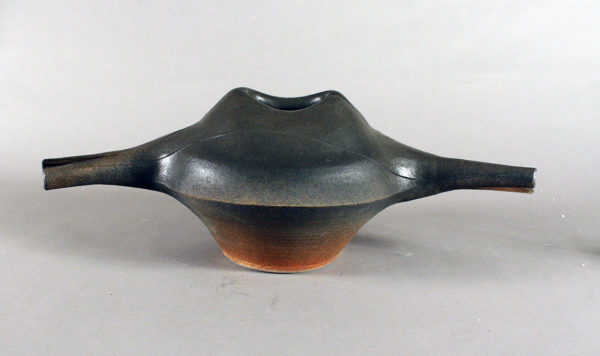
Karen Karnes, Winged Vessel, n.d., stoneware, 10 in. x 24 3/8 in. x 14 in., Gift of Fred McBride
JANUARY 26 –APRIL 7, 2019
Lecture and Opening Reception: January 26
This year, the Ceramic Annual, the longest-running exhibition of contemporary ceramics in the nation, turns 75! Curator Kirk Delman, who has worked with the collection for decades, has selected a wide variety of works from the College’s renowned Marer Collection to display in the exhibition. Fred Marer, a collector of mid-twentieth century art, befriended and supported some of the greatest ceramic artists of the time. Many of the works he purchased directly from those artists will be on display as we celebrate 75 years of ceramic exhibitions. The Ceramic Annual lecture, given by gallerist and curator Frank Lloyd, will be held at the Humanities Auditorium on Sat., Jan. 26, at 4 pm, followed by the opening at the gallery, from 7 to 9 pm.
SCRIPPS SENIOR EXHIBITION
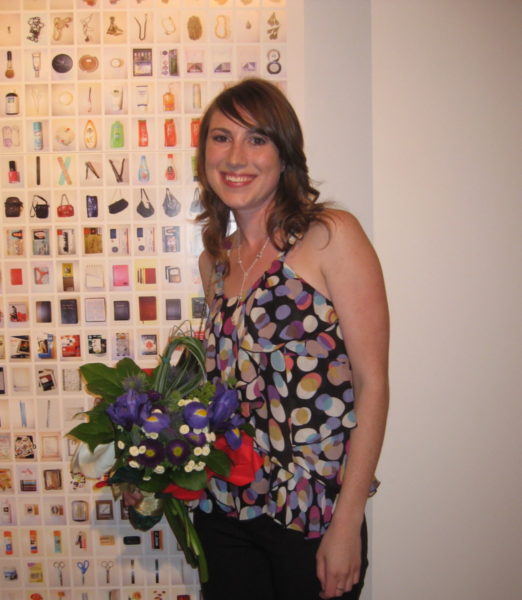
Rachel Edwards ’10 with her work at the Senior Exhibition.
MAY 3 – MAY 18, 2019
Opening: May 3, 7-9 p.m.
Anyway is this year’s annual exhibition of final thesis projects created by graduating studio art majors. The Senior Art Show is a cornerstone of the studio art major at Scripps and the projects on display have been in production over the course of the past year. In addition to producing the works displayed, seniors conceptualize the show, install their pieces, write artist statements, and design publicity for the exhibition. Works are displayed in the gallery for two weeks, through the end of commencement, from May 3rd through May 18th. An opening reception will be held at the gallery from 7 to 9 pm on Friday, May 3rd. The reception and exhibition are free and open to the public.
This year’s featured artists are all members of the Scripps College Class of 2019. They include: Molly Antell, Rowen Cox-Rubien, Catherine Glah, Tirza Jo Ochrach-Konradi, Morgan Stewart, and Cindy Zhu. Anyway includes digital illustration and painting, alternative photography, film, and sculpture.
The gallery is open from Wednesday through Sunday, noon to 5 pm, during exhibitions. For more information, please call (909) 607-3397.
Lectures:
Fragrant Visions
Painting Buddhist Ritual in China, Circa 1178
Wednesday, October 10, 7 p.m.
Steele Hall, Rm. 101
Phillip Bloom is the June and Simon K.C. Li curator of the Chinese Garden and director of the Center for East Asian Garden Studies at the Huntington Library, Art Collections, and Botanical Gardens in San Marino, California. He will focus on a few paintings that actually depict the performance of Buddhist rituals, and discuss how those depictions link real practice and imagined visions.
Roles of the Museum Conservator
Monday, February 4, 2019, Noon
Hampton Room, Malott Commons
Geneva Griswold ’07, Associate Conservator, Seattle Art Museum, will present her lecture as part of the Art Conservation Lecture Series, Tuesday (though this lecture will be held on a Monday) Noon Academy.
The Art Detectives:
How to Cheat Time, Investigate Art, and Sustain Culture
Each lecture in The Art Detectives series will be held in Steele Hall 101 from 7 to 9 pm. Light refreshments follow the presentations. These lectures, free and open to the public, are funded by the Spencer Program.
March 6 – Art Forensics or How to Tell Real Art from Fakes:
Explore the use of forensic science to authenticate works of art. See how science, history, law and ethics intersect in increasingly complex and interesting ways around plunder, fakes and forensics.
March 27 – Artist Materials from Ancient to Modern Times:
Discover artists’ materials that are vulnerable. Find out how modern art can be preserved. Examine artists’ materials, including the invention of ancient pigments. Hear why some of Van Gogh’s paintings have changed color.
April 10 – Art Detective Object Lessons:
Five stories reveal how scientists help us to understand and sustain our art and culture. (Example: Lessons learned from the Iceman not only revealed secrets of the Bronze Age but also about the preservation of fragile materials.)
Eric Doehne, Ph.D., is a conservation scientist specializing in the intersection of art and science, heritage and legacy. Doehne served as a staff scientist at the Getty Institute, and was international chair of the PATRIMA project in French cultural heritage preservation. He currently teaches at Scripps College, and consults with ConservationSciences.com.
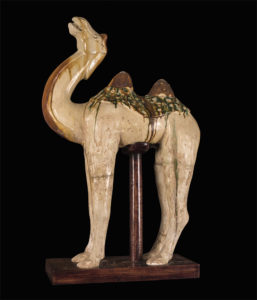
T’ang Dynasty Camel, China Anonymous, 8th c., earthenware, 24 3/4 in. x 5 3/4 in. x 16 in., Gift of Mrs. Jean Ames’ Estate, Scripps College, Claremont, CA
ART BITES
Short Lunchtime Talks on Individual Works in the Collection
Hosted by Meher McArthur
Gabrielle Jungels-Winkler Curator of Academic Programs and Collections
ART BITES SPRING 2019: A Quick Bite of Ceramics
All spring talks will be held at the Ruth Chandler Williamson Gallery at 12:30 pm.
Wednesday, February 6
Camel Tomb Ceramic, China, Tang dynasty (618-907), glazed earthenware
Wednesday, February 13
Whistling Water Jug, Peru, 3rd to 9th century AD, earthenware with oxidized iron black finish
Wednesday, February 27
Shigaraki Tea Bowl, Japan, 20th century, stoneware with natural ash glaze
Wednesday, March 6
Two Bowls, China, 17-18c, porcelain with cobalt blue underglaze
Wednesday, March 13
Sculpture, 1956
Ceramic sculpture by renowned ceramicist Peter Voulkos, USA
(For more information, please contact [email protected])
ART BITES FALL 2018
Each talk begins at 12:30 pm.
September 19, Clark Humanities Museum
Female Buddhist Deity Tara, Nepalese, 18–19th century, bronze
September 26, Ruth Chandler Williamson Gallery
John Mason, Container (X), 1959, glazed stoneware
October 3, Ruth Chandler Williamson Gallery
Katsushika Hokusai, Hodogaya on the Tokaido Road, c. 1829, woodblock print, ink and colors on paper
October 10, Ruth Chandler Williamson Gallery
Henri Cartier-Bresson, Marilyn Monroe and Arthur Miller, 1960, gelatin silver print on paper,
October 17, Margaret Fowler Garden
Alfredo Ramos Martínez, Mural, 1945-46

Alfred Ramos Martinez, The Flower Venders, Mural (Detail), 1946, 83 1/16 x 1182 11/16 in., Scripps College, Claremont, CA
For events and Gallery visits, please note:
All locations are on the Scripps College campus. The map of the campus can be accessed here.
Dates are occasionally subject to change. Events are open to the public. Admission is free.
The Gallery is only open during exhibitions. Hours: Wednesday through Sunday, from noon to 5 pm.
While selected works from the permanent collection are displayed in exhibitions each year, the permanent collection is not on display.

